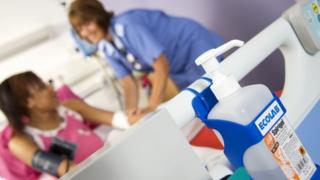 Image copyright
Science Photo Library
Image copyright
Science Photo Library
MSPs will start hearing evidence later about safety and infection rates in Scotland's NHS.
The inquiry was launched by Holyrood's health and sport committee after a series of infection outbreaks at the Queen Elizabeth University Hospital in Glasgow.
Two people died after contracting an infection related to pigeon droppings.
The committee's probe will have a wider focus than an investigation into the QEUH ordered by the health secretary.
The MSP's inquiry was set up after problems with ventilation, water hygiene and building maintenance were identified at Scotland's largest hospital.
They want to examine whether infection control is adequate and whether more can be done to improve patient safety.
The committee has already accepted written evidence and will hear from executives responsible for managing and monitoring safety in healthcare settings.
Ahead of the session, the committee's convener Lewis Macdonald said: "Recently there have been increasing incidents of infection in Scotland's hospitals raising serious questions about the safety and control of our healthcare environments.
"Our session on Tuesday is vital for the committee to learn the scale of the problem and ensure robust measures are in place to combat any issues.
"This evidence session will allow us to hear directly from those responsible for the healthcare facilities in Scotland and we will ensure any issues raised are brought to the attention of the Scottish government."
'Contributory factor'
In December, a 10-year-old boy and a 73-year-old woman died after contracting the fungus Cryptococcus, which is linked to bird droppings.
In the case of the child, it was a contributory factor in his death. Although the woman was found to have the fungal infection it was not the cause of her death.
Both cases are being investigated by the Crown Office.
The Cryptococcus which was found is believed to be from pigeon droppings located in a plant room on the hospital's roof.
Prosecutors are also investigating the death of a third patient at the QEUH. A 63-year-old woman was one of two patients affected by the fungal infection Mucor in January.
Separately, 23 children contracted bloodstream infections in the cancer wards at the Royal Hospital for Children - which shares the Queen Elizabeth campus - between January and September last year.
The infections were thought to be linked to bacteria in the water supply - with a report later finding "widespread contamination" at both hospitals.
The inquiry also follows the death of a patient at the Royal Alexandra Hospital in Paisley on 7 February after contracting the hospital infection Stenotrophomonas maltophilia. The bacteria was named as a contributing factor in the death.
And two babies died after contracting the Staphylococcus aureus bacterium at the Princess Royal Maternity Hospital in January.